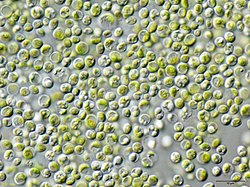| Chlorellales | |
|---|---|
 | |
| Chlorella vulgaris | |
| Scientific classification | |
| Kingdom: | Plantae |
| Division: | Chlorophyta |
| Class: | Trebouxiophyceae |
| Order: | Chlorellales H.C.Bold & M.J.Wynne, 1985 |
| Families | |
The Chlorellales are an order of green algae in the class Trebouxiophyceae. [1]
The Chlorellales include mostly freshwater or terrestrial (rarely marine), coccoid algae. [2] Molecular phylogenetic studies mostly tend to find Chlorellales to consist of two sister clades, corresponding to Chlorellaceae and Oocystaceae; however, in some studies the two are not sister to each other, making Chlorellales not monophyletic. [3]
Genera of uncertain placement include: [4]